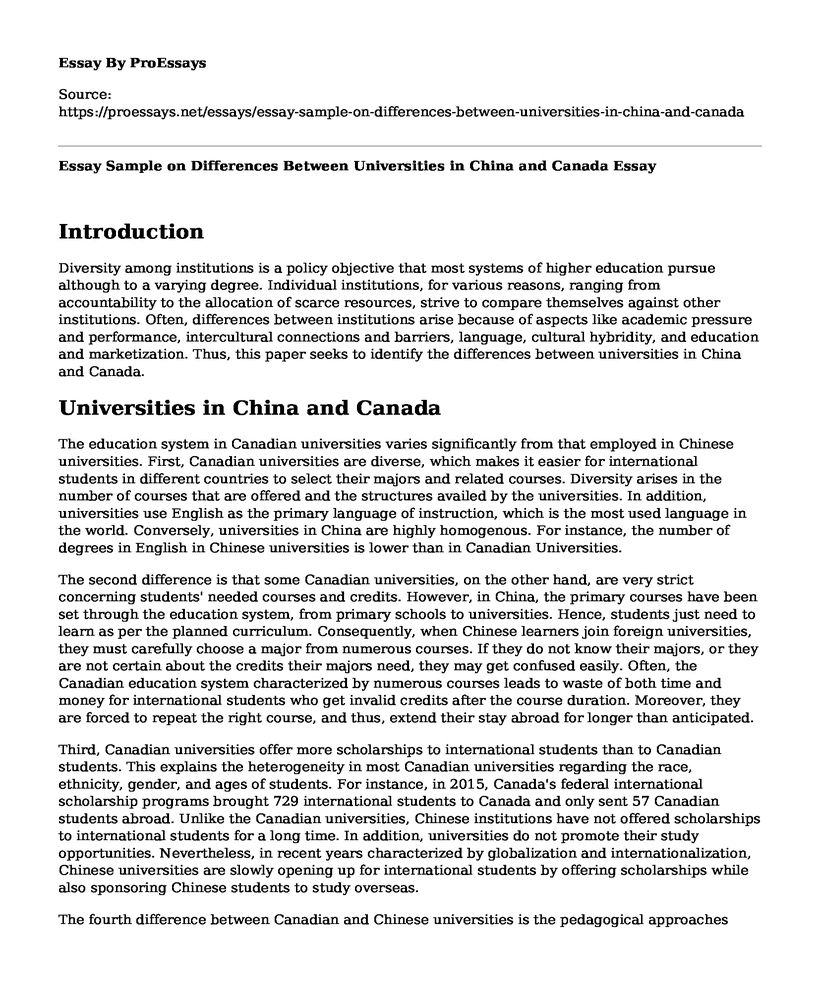Introduction
Diversity among institutions is a policy objective that most systems of higher education pursue although to a varying degree. Individual institutions, for various reasons, ranging from accountability to the allocation of scarce resources, strive to compare themselves against other institutions. Often, differences between institutions arise because of aspects like academic pressure and performance, intercultural connections and barriers, language, cultural hybridity, and education and marketization. Thus, this paper seeks to identify the differences between universities in China and Canada.
Universities in China and Canada
The education system in Canadian universities varies significantly from that employed in Chinese universities. First, Canadian universities are diverse, which makes it easier for international students in different countries to select their majors and related courses. Diversity arises in the number of courses that are offered and the structures availed by the universities. In addition, universities use English as the primary language of instruction, which is the most used language in the world. Conversely, universities in China are highly homogenous. For instance, the number of degrees in English in Chinese universities is lower than in Canadian Universities.
The second difference is that some Canadian universities, on the other hand, are very strict concerning students' needed courses and credits. However, in China, the primary courses have been set through the education system, from primary schools to universities. Hence, students just need to learn as per the planned curriculum. Consequently, when Chinese learners join foreign universities, they must carefully choose a major from numerous courses. If they do not know their majors, or they are not certain about the credits their majors need, they may get confused easily. Often, the Canadian education system characterized by numerous courses leads to waste of both time and money for international students who get invalid credits after the course duration. Moreover, they are forced to repeat the right course, and thus, extend their stay abroad for longer than anticipated.
Third, Canadian universities offer more scholarships to international students than to Canadian students. This explains the heterogeneity in most Canadian universities regarding the race, ethnicity, gender, and ages of students. For instance, in 2015, Canada's federal international scholarship programs brought 729 international students to Canada and only sent 57 Canadian students abroad. Unlike the Canadian universities, Chinese institutions have not offered scholarships to international students for a long time. In addition, universities do not promote their study opportunities. Nevertheless, in recent years characterized by globalization and internationalization, Chinese universities are slowly opening up for international students by offering scholarships while also sponsoring Chinese students to study overseas.
The fourth difference between Canadian and Chinese universities is the pedagogical approaches lecturers use in the classrooms. In Chinese universities, Chinese lecturers use traditional Chinese instructional strategies based on the idea of "rotate learning, skill comes". Hence, learners have to memorize the content instead of understanding it. In addition, Chinese lecturers just lecture without engaging students actively. Such a teaching approach lowers the morale of students, and consequently, their academic performance. Notably, this differs in Canadian universities where lecturers' teaching approach focuses on developing the students' thinking, ability, and personality. Instead of memorizing answers, students in Canadian universities learn to analyze content critically, which broadens even the way they perceive life. Additionally, students actively participate in discussions, group work, debates, and have numerous platforms to air their perspectives and opinions.
Further, this difference extends even to the assignments that lecturers give. Assignments in Canadian universities are practical and interesting since learners have to employ their imagination to air their opinions. Nevertheless, in Chinese universities, assignments are examination-oriented, are based objectively on facts, and focus majorly on learners' memorization and analytical skills. Consequently, graduates from Canadian universities exhibit more creativity and independent thinking than those from Chinese universities. Hence, it is clear that education in Canadian universities is designed to prepare students to become useful members of society, creating strong and sustainable friendships, and acquiring adequate skills and awareness necessary for gaining employment. Conversely, education in Chinese institutions appears to be more competitive. Universities not only trains students to prepare for useful lives but also strive to assess and sort them to eventually choose individuals for the most appropriate positions in life.
Conclusion
To conclude, it is clear that universities in Canada vary significantly from those in China. Such differences arise from educational policy and system difference between the two countries. For example, while Canadian universities and heterogeneous, Chinese universities are highly homogenous. In addition to composition differences, universities in both countries differ in mindset, expectations, and practices. While Canadian universities strive to develop well-rounded members of society, Chinese universities are exam-oriented and attempt to create individuals for the most appropriate positions in life. They focus majorly on learners' memorization and analytical skills. Similarly, while Chinese universities are striving to open up by offering scholarships, Canada remains rigid in sponsoring its students to study abroad. Notwithstanding, despite the diversity, these differences create the uniqueness of each country's education system.
Cite this page
Essay Sample on Differences Between Universities in China and Canada. (2022, Dec 13). Retrieved from https://proessays.net/essays/essay-sample-on-differences-between-universities-in-china-and-canada
If you are the original author of this essay and no longer wish to have it published on the ProEssays website, please click below to request its removal:
- Essay Example on Funding of Public Schools
- Early Literacy Assessment Essay
- Discussion on the Current Research That Links Patient Safety Outcome to ADN and BSN Nurses
- Letter of Intent for National Honor Society
- Activities That Promote Social Skills in the Classroom Essay Example
- Paper Example on Phone Interview at Walden University: Data Collection & Instrumentation
- Essay on Observation of Classroom Dynamics at University







